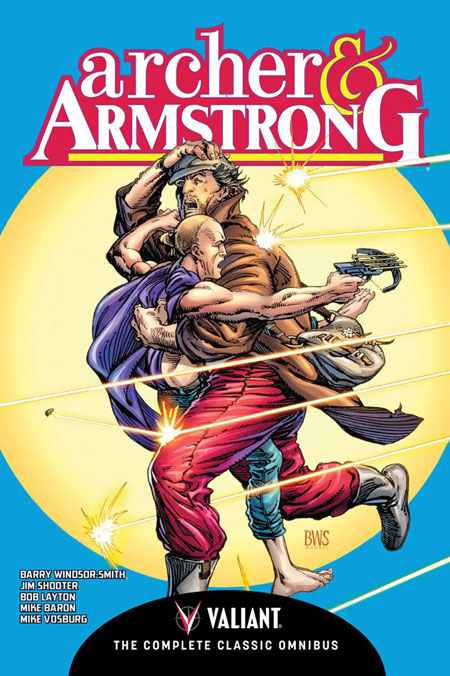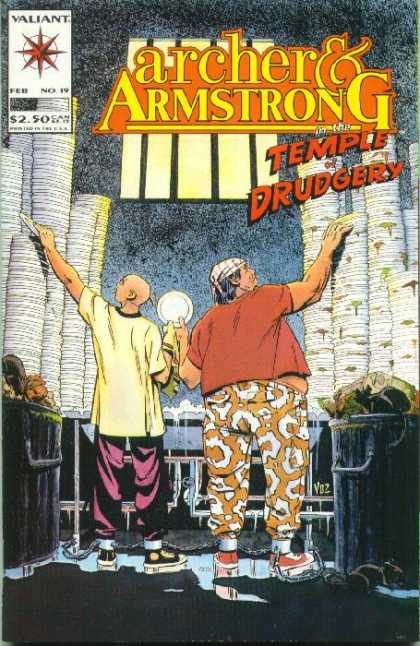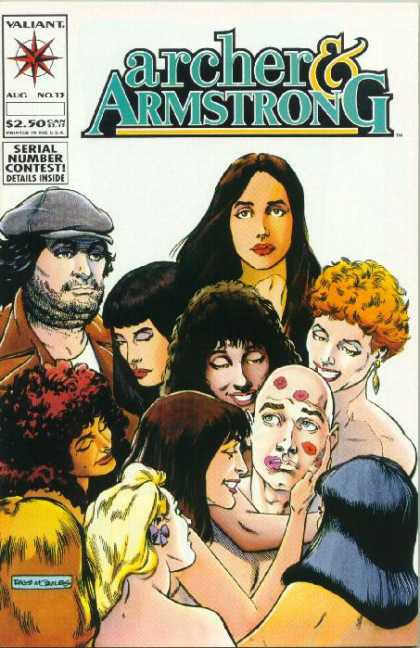Archer & Armstrong: The Complete Classic Omnibus
By Hervé St-Louis
July 7, 2020 - 00:03
Valiant Entertainment
Writer(s): Mike Baron, Bob Layton, Jim Shooter, Barry Windsor-Smith
Artist(s): Mike Vosburg, Barry Windsor-Smith, Rags Morales
Colourist(s): Maurice Fontenot
Cover Artist(s): Barry Windsor-Smith
ISBN: 978-1939346872
$99.99 USD, $132 CAD, 736 pages
Release Date: January 26 2016
 |
The Archer & Armstrong Complete Classic Omnibus collects most of the Valiant Heroes One universe stories (VH1) in one hardbound edition first published in 1992. As I have written many times over the years, I am one of those now rare Valiant comic readers who were there before Unity and had most of the early issues. Valiant was one of my favourite publishers back then and nostalgia is making me care about the publisher again.
But old fans tend to be picky and fickle. We only like one kind of thing. I read the new version of Archer and Armstrong—Valiant Entertainment Inc (VEI) and while they were very funny and with a writer more committed to the comic, I never really cared as much and did not follow the series. It is a shame as it was one of my favourite comics in the 1990s. I intend to remediate this situation and see if I can find enjoyment in the new current Valiant Universe. Since the Bloodshot movie, I have become more aware of what Valiant has been doing.
First, as documented elsewhere on this site, although I once owned all of the initial run of Archer and Armstrong by Barry Windsor-Smith, I lost them in a flood that took away my extensive comic collection Calgary in 2013. The omnibus for me was the only way to get these cherished comics again, and marvel at the fun universe created by Windsor-Smith, Jim Shooter, Bob Layton, and many others. I recall dropping Archer and Armstrong when Windsor-Smith ended his run on the series, and it was inherited by writer Mike Baron and with the help of perennial cartoonist Mike Vosburg.
Mike Baron is an odd man as his Nexus series has always been excellent and choke full of social commentary. While his take of Archer and Armstrong was good enough, it never matched the irreverence of Windsor-Smith whose stories were more focused on a clear line of action and themes and even though they scratched the realm of bad philosophy many times. Baron’s stories became a buddy comedy first, then a sitcom where little drove the characters. Particularly, his take on Armstrong removed all trials and perils by making him just a millionaire who could buy anything, never die, nor get seriously hurt. He has no growth in the stories written by Baron.
Archer, of course, had much more fodder to work with but the character still felt directionless under Baron. Several times, baron did attempt to provide Archer with a strong life objective. Which is quite helpful with such characters. The Archers of this world grow when they are on a hero’s journey. But every new story arc, Archer seemed to have a new life goal, dropping whatever he had set his mind on in the previous story. Significant changes, like him suddenly knowing how to drive changed the character without ever being addressed in the stories. Not being able to drive was a serious limit to the character that was played for laughs by Windsor-Smith. Too many dangling plotlines, like the many would-be girlfriends of Archer, the murderous German neighbour, the old villain who had stolen Armstrong’s paintings, and the many enforcers who had attacked Archer and Armstrong were never resolved before the series was cancelled. But by then, it seemed that Baron had run out of crazy schemes for the heroes.
The inconsistent artwork by many guest artists following the end of Windsor-Smith’s run was the first hit taken by the series. How can one replace such an epic cartoonist such as Windsor-Smith? Valiant had tried to develop and house style, grooming nascent artists so they could take on any comic at the publisher. It had worked for David Lapham whose Harbinger work allowed him to grow into the super cartoonist we all revere today. Bu most of the other illustrators disappeared from comics. Two exceptions are worth noting. Rags Morales lent his hand for one lacklustre issue with subpar inking by John Dixon.
 |
The other point of deterioration after Windsor-Smith left was the loss of colourist Maurice Fontenot. Fontenot was one of those early Valiant colourists who used watercolours. These gave Valiant a distinct look and feel which seemed less mechanical than the early soft-edged digital colouring that had taken over at Image Comics and Marvel at the time. The palette was richer with nice textures. Vosburg did colour a few of his own issues but the richness brought by Fontenot was never fully reproduced. Later, in the series, it appeared that valiant fully converted to the cold and mechanical digital colouring that still plagues comics today.
The colouring as reproduced in this omnibus is a serious problem. The gamma on the colours seems to have been pushed to the limit, which destroys some of the nuances in the original work while often making the text difficult to read. Characters appear much darker than they should be. Black characters fare the worse with this kind of faulty colour correction. I like the idea of reprinting the older comics from Valiant but in the future the publisher will have to learn to be more careful with the restoration of older comics. You cannot just scan older comics or reuse old print films without fully restoring them and being careful with applying a one size fit all levels of correction to the work. The Barry Windsor-Smith pages fare much better than the Vosburg material which is poorly printed in the omnibus.
And now, what you’ve all been waiting for. Yes Windsor-Smith was a giant in this run of Archer and Armstrong. He was early Valiant’s powerhouse artist. His style fitted the least with the house look developed by Valiant. However, the energy and dilettante approach to the series set it apart from any other comic at the time. Baron and the current incarnation of Archer and Armstrong all draw from this seminal work. Strangely enough, I view this run of Archer and Armstrong as the equivalent of any of the best material from John Byrne, such as his Superman, Alpha Flight, or Fantastic Four. But unlike Byrne, Windsor-Smith has much less of that kind of body of work when compared to Byrne or even Walt Simonson.
I have to mention this. I have written about this elsewhere in past articles on Archer and Armstrong but Windsor-Smith was obsessed with phallic symbols in his works, especially when it concerned Archer who was naïve and appears to have remained a virgin throughout the run. Today, people would say that the character was probably gay. Yes, he could be. What has always amazed me about Windsor-Smith is that his women were much like Michelangelo’s female figures in Archer and Armstrong. Much like Michelangelo, they were muscular, and men used as models for female depiction. Archer’s wife, Andromeda feels very manly. Her gestures were not feminine at all.
When Windsor-Smith wrote and drew Archer and Armstrong, buddy comedies were not as established in comics. The humour was subtle, and the plots contrived by historical errors. But the comic was remarkable because it paired two unusual characters together. In the 2012 remake of Archer and Armstrong, their costumes have been streamlined to fit the superhero ethos better. Archer has a big star logo on his chest instead of a towel which for some reason does not seem to fall off when he fights. He looked like a monk and was less of the clean-cut born-again Christian that graces the revival. Armstrong was a bum and not just a fat unshaven suburbanite as seen in baron’s version or some weird comic book guy in the current incarnation. He had more character.
An important quality of these early issues by Windsor-Smith which probably stems from the strong editorship of Jim was that every adventure fit in a timeline. The continuity was tight. With Baron, none of that mattered which is why we see Archer being able to drive a car when a major plot point in early issues was that he could not.
 |
Archer and Armstrong was a favourite comic back then. It was really for the older kids and college students. The vision behind all of these comics is what attracted so many and made us give a chance to another publisher that was not DC nor Marvel Comics. Reading these older comics felt like reading them for the first time. It has been literally 28 years since I first read them. I don’t recall when I dropped the Baron/Vosburg run but I certainly know that I had not read any of these comics before.
For completists, a few extra issues and crossovers are included. Most are unnecessary but it is good to have them. What is missing from these books are forewords or closing comments by creators or comic historians about the comic. But then again, I guess that’s why you are here, reading this article by a real fan of the original comic and a comic historian to boot!
As Archer and Armstrong are being developed for film, these early comics take more significance. The buddy comic is easy to grasp but ignoring the cement that allowed the current series to thrive is a loss. As mentioned above, the restoration attempt of the omnibus is poor when compared to the works of IDW Publishing and other publishers who take the old stuff seriously. But the comic is alive for those who were not around when it was first published or too young to know better. It is a fantastic series of opposites attract. It was also an addictive read, even when I began the Baron run. I do not get as interested in comic this way easily anymore. The omnibus is expensive. If you can still find it, get it. It is some of the best material from the 1990s Valiant Comics.
Rating: 8/10
Related Articles:
Archer & Armstrong: The Complete Classic Omnibus
Archer and Armstrong Are Tintin and Captain Haddock
Review: Archer and Armstrong #22
Archer & Armstrong #14 Advanced Preview
Archer & Armstrong #11 is [Redacted]!
Archer and Armstrong #0 Advanced Review
Archer Versus Everyone in Archer & Armstrong #9!
Archer & Armstrong #0 - The Top Secret Story of History's First Epic Fail!
Archer and Armstrong #8
Archer and Armstrong #7 – A Dissenting View
